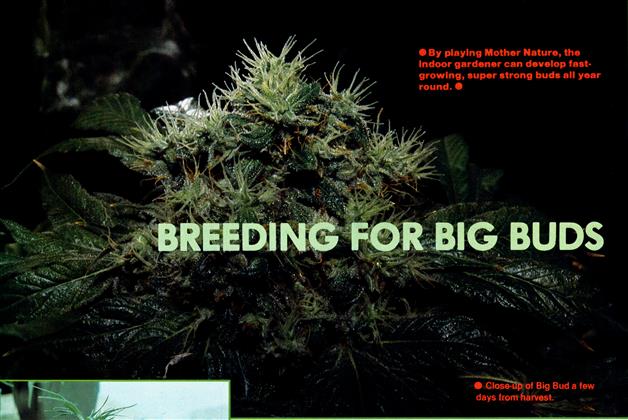Original publication: November 1986.
BREEDING FOR BIG BUDS
HARVEST ’86
BY JORGE CERVANTES
“Look at the size of that thing, I must be hallucinating,” said Tim as he stared in awe at the huge six-inch diameter flower top. “What did you put in this joint to make me see things twice as big as life? I mean, that is the biggest bud I’ve ever seen!”
“We call her Big Bud. I think she is 100% Indica,” replied James with a big smile. “I brought her back to Detroit from out West. Here, give her a try,” said James, passing Tim a bomber of Big Bud.
Tim put the spliff between his lips and gently drew a few breaths through the unlit joint. “So fresh and minty, it’s the best I’ve ever tasted. I take back all the bad stuff I said about indoor smoke,” Tim said with a pleased sheepish grin.
“They’ve been breeding some incredible plants out on the West Coast. When I was there, indoor growers were talking about the Hash Plant that matures into a 36″ tall two-three ounce plant (dried tops only) after eight weeks of flowering: stout, broad tops laden with thick gooey resin. Or Lime Bud, a Sativa/lndica cross, with long, dainty, lime green leaves and lightweight buds packed with pistils and glistening resin glands. Or Northern Lights, a mainstay variety in Vancouver, B.C. that matures into a four-foot, four ounce plant at the ripe old age of 85 to 90 days. But everyone’s favorite is Big Bud because she grows huge buds and has the sweetest, mintiest taste in the world. My last crop weighed in at 3 1/2 pounds, that’s better than four ounces a plant!”
Narrow leaves show classic qualities.
All of these varieties were developed by industrious, careful and caring individuals that have kept meticulous detailed records of plant growth habits and the offspring that resulted when they crossed a male plant with a female. Indoor breeding is two or three times faster than outdoors. As many as three generations may easily be completed in one year indoors. The breeder controls the hours of light and darkness per day, causing the plants to flower and produce seed at will.
Selective breeding (also known as selective sexual propagation) has completely changed the quality and yield of indoor marijuana crops. The starting point is to collect marijuana seed from well known pot growing regions throughout the globe. The various seed strains are grown and studied thoroughly without any cross breeding. Once each is understood, then selective breeding can begin, either to attain a pure seed stock, or to improve the strain. Once the ultimate plant is developed through this sexual propagation, it can be cloned to preserve the genetic blueprint created by selective breeding.
Cannabis Indica seeds are highly prized for their potency and adaptability to the indoor environment. The characteristics of Indica plants include: squat, bushy, vigorous growth; early, sustained potency; disease resistance; and heavy bud yield. An Indica plant may yield two to four times the dry bud weight of a Sativa at harvest. Thai, Colombian, and Mexican are examples of Cannabis Sativa. These Sativa varieties are tall, lanky, and disease resistant, with narrow, long leaves and light buds that take up to three months to mature. But the high is energetic, soaring, and clear.
Ideally, skilled breeders will strive to retain the desirable dominant growth characteristics of both Cannabis Sativa and Cannabis Indica to form super strains. Breeders may cross a Sativa with an Indica, hoping to retain the desirable soaring high while keeping the short, stocky growth characteristics and early maturity of the Indica.
This single indica female bud is being fertilized by male pollen in the plastic baggie.
Selective breeding requires the breeder to simply assume the role of Mother Nature once again. In nature, pollen from the male cannabis plant is shed into the wind to randomly fertilize any receptive female plant. A breeder adds precision and control to this process by catching pollen from a desirable male and carefully placing it in contact with chosen female pistils.
Two basic kinds of breeding are: (1) inbred or true bred—plants of the same strain or ancestry that are crossed with one another. (2) outbred or hybrid— plants of different strains that are crossed or cross-pollinated.
The goal of inbreeding is to establish a pure breed to start from. Selected females are pollinated with male pollen of the same strain, then the resulting seeds are planted and checked for variability. This process may take several generations to produce a strain that actually breeds true. Pure bred plants are grown until the fifth to sixth generation, after which negative characteristics, like low potency, legginess and lack of vigor tend to dominate.
This true or pure breed is essential to establish common growth characteristics. Without a pure breed on one or both sides, it is difficult to predict the outcome of a hybrid cross. Ideally, both male and female are pure-bred plants, with known ancestry and growth attributes.
A hermaphroditic plant (a plant displaying both male and female flowers) will self-pollinate and produce inbred seeds. Although this is a shortcut to inbreeding, the seedlings resulting from self-pollination may tend to be hermaphroditic themselves. This can be a real headache for the sinsemilla grower or breeder, with unwanted seeds and uncontrolled pollen. Nonetheless, the seed produced by a hermaphrodite that has just a few male flowers on a female plant will be 80-90% female seed. One easy way to produce seeds from an all female clone crop is to stress one of the female branches by twisting a piece of wire around one of the branches a couple of weeks before flowering is induced. The extra stress will usually cause the plant to produce male flowers.
Outbreeding, or producing hybrid seed, has increased agricultural production more than anything. Farmers, breeders and cannabis horticulturists have found that crossing parents of different pure strains, especially those exhibiting exceptional, dominant, complementary characteristics, will result in a super plant, also referred to as hybrid vigor.
It is possible to cross Sativa/lndica. Some growers swear by the cross, saying you get the best of both plants: vigor and size from the Sativa, and squat, bushy, early, potent growth from the Indica.
Choosing from a large and varied plant stock is the key to successful breeding. Since the origin of most seed is dubious, an accomplished breeder waits to see what kind of plant it produces, before deciding which plants to cross to form hybrid seed. If the breeder plants only a few seeds, there is no guarantee that they will grow into ideal breeding stock, even if they came from dynamite smoke. If the breeder instead selects the best plants from many seedlings of various strains of Cannabis Indica (and/or Sativa), he or she will have a better chance of achieving the desired outcome.
BREEDING: STEP-BY-STEP
STEP ONE: Choose male breeding stock exhibiting desirable characteristics.
STEP TWO: One branch full of male flowers is all that will be needed, unless a large crop is desired. Unused branches may be stripped of flowers to help contain pollen and guard against accidental, random pollination. The male can be isolated from the females, once flowers have developed, but not yet opened, by placing him in a sunny window or in a vegetative grow room. This will slow flower development and not hurt the male in any way.
A branch of ripe, male flower may be cut and placed in water. It will remain healthy for several weeks. When the pollen sacks open, proceed with Step Three. The remaining male plant may then be cut back or harvested.
Skilled breeders will cross a Sativa with an Indica, hoping to retain the Sativa’s soaring high while keeping the stocky growth and early maturity of the Indica.
STEP THREE: When the pollen pods start to open, place a clean, plastic sack or baggie over the branch to collect pollen. Secure the bag at the bottom with a piece of string or wire tie. Keep the bag over the branch for several days to collect pollen.
STEP FOUR: When enough pollen has been collected, shake remaining pollen off into the bag. Remove spent branch. Pollen may be kept for several weeks by removing all vegetative matter to prevent mold, and storing the pollen in a dark, dry container in the refrigerator.
STEP FIVE: Ideally, pistils should be ready for fertilization three to four weeks after the first calyx has appeared. Receptive pistils are white and fuzzy, not starting to turn brown. Cover the selected female branch that has many ripe, receptive pistils with the pollen-filled bag. Shake the bag.
STEP SIX: Use a small paint brush to apply the pollen from the bag to the pistils if just a few seeds are desired from many different females. Be very careful. Just use a little pollen on each calyx and keep it from spreading to the sinsemilla crop.
STEP SEVEN: Leave the bag for two or three days, to ensure fertilization. Be careful not to scatter pollen on adjacent sinsemilla crop when removing the bag.
STEP EIGHT: After fertilization, seeds will be ripe in three-six weeks. Harvest seeds when they split open the containing calyx or rattle in the pod.
STEP NINE: Let seeds dry for two to three months, in a cool, dry place, before planting.
This is the eighth in a series of articles by Jorge Cervantes, author of the bestselling INDOOR MARIJUANA HORTICULTURE, known by many as the Bible of indoor growing. The series outlines indoor growing from A-Z, for both novices and experienced gardeners alike.





























































